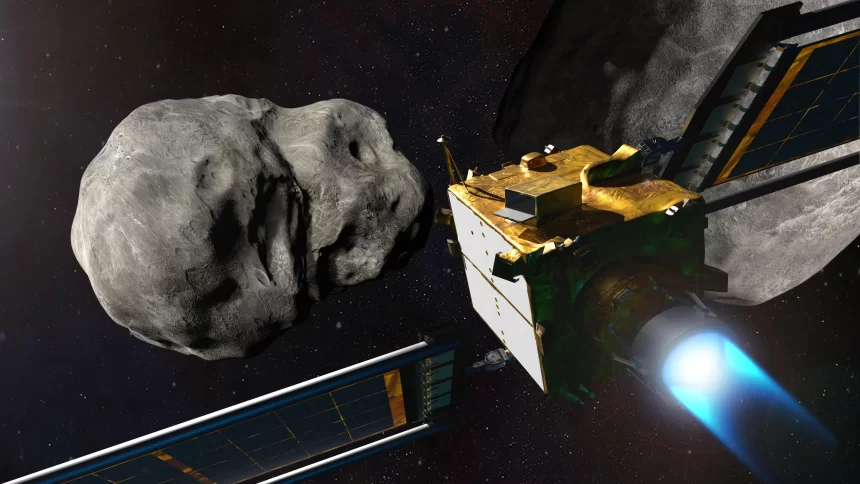News NASA’s Trailblazing The DART Mission Reveals New Details Based on its findings, the Double Asteroid Redirection Test (DART) mission helped unlock hidden details about how its target binary asteroid system originally formed and is constructed. Two recent studies released in Nature Communications reveal stunning news about the Didymos-Dimorphos system, deepening our knowledge of dynamics of asteroid and effectiveness planetary defense methodologies.
Unlocking the Mysteries of Didymos and Dimorphos
The DART mission was designed as the first demonstration test of the kinetic impactor technique to change an asteroid’s motion in space. It was a test of tech designed to see if we can nudge any future Earth-threatening asteroids off course; by bashing into Dimorphos, the small moonlet in orbit around larger asteroid Didymos. This most recent research now paints an extremely detailed geological and physical portrait of these moons offering dramatic clues into how they were formed, as well their surface properties.
Key Findings from The DART Mission Data
Geological Characteristics
Data gathered by DART as well its companion LICIACube from the Italian Space Agency (ASI) has revealed geological traits of Didymos and Dimorphos. In a search led by Olivier Barnouin and Ronald-Louis Ballouz of the Johns Hopkins Applied Physics Laboratory (APL), Dimorphos looks extremely rough, with many different boulder sizes; meanwhile Didymos shows smoother lower-lying areas riven with craters as well as more rugged highlands.
The scientists suggest Dimorphos was likely created by one of Didymos biggest mass-loss events. In particular, the presence of a triangular ridge and smoother young terrain on Dimorphos compared to Didymos is some evidence in support of this hypothesis. The fact that Didymos is 40 times older than Dimorphos (12.5 million years old compared to less than half a megayear) points also reveals the largely different evolutionary stages of these asteroids, shaped in their interiors over time by different dynamical processes.
Spin-Up and Surface Dynamics
The DART mission also provided new observations about the spin-up of Didymos that may have helped to create its equatorial ridge and thereafter crated Dimorphos. Didymos and Dimorphos internal properties might suggest that Didymos started shedding material as a result of this spin-up phase, creating the small moonlet. The spin-up disruption model describes the origin and evolution of Dimorphos, with an emphasis on the importance of non-gravitational effects caused by asteroid spin.
Surface Material Analysis
The study, led by Maurizio Pajola of the National Institute for Astrophysics (INAF), used differences in boulder shapes and distribution across these surfaces to piece together what asteroid interiors might look like. “Based on our model, we think that Dimorphos likely originates from material ejected after most of the bulk volume loss of Didymos,” said Pajola’s team in a presentation they will deliver Tuesday at LPSC. It shows this formation pathway is in line with how we think rubble-pile asteroids are put together.
Thermal Fatigue and Surface Alteration
Alice Lucchetti for one and more acquainted also with the impact of thermal fatigue on Dimorphos, a seemly harmless distance future beyond Earth object. This revealed that thermal stresses could quickly destroy boulders and change surface properties, which has never been documented in the study of asteroids. This result is giving us an entirely new understanding of the degree to which asteroid shapes can be modified, and it also tells you about how common such heating events are in our Solar System.
Bearing Capacity and Surface Strength
Under the supervision of ISAE-SUPAERO’s Naomi Murdoch, a study has investigated how strong Didymos’ surface is and revealed that it is at least 1,000 times weaker than dry sand or lunar soil. The low surface strength was key in determining how muchThe DART’ Mission impact would change Dimorphos’ orbit. We need to know this for predicting what asteroids will do when we try out our impactor missions on them down the line.
Comparative Analysis of Asteroid Boulders
Dimorphos’ boulders were also compared to the rubble-pile asteroids Itokawa, Ryugu and Bennu in Colas Robin’s research. Similarities among the surface features of these asteroids point toward a shared evolutionary history shaped by impact processes.
Future Implications and Upcoming Missions
The DART Mission is dawning new planetary defense tools and revealings of asteroid systematics. Now we have a baseline for those future efforts — in 2026 the European Space Agency’s Hera mission will return to the Didymos-Dimorphos system, and these findings could help us understand how things have changed at this post-collision point, as well as guide our techniques using impact mitigation.
Support Space Exploration
If you are interested in complementary options to provide information and additional support of the topic of space exploration and asteroid-related activities, I would recommend the following products and educational, easy-to-comprehend resources. Quality telescopes and books on space exploration will be perfect for those who are excited to discover the universe.
Conclusion
An Introduction To NASA Is DART Mission And The Incredible Science Of Exploring Dynamic Didymos ASimpleHomemaker Mapping the geological and physical properties of these asteroids, in doing so (), also improve our understanding of how planets could impact asteroid evolution. While we anticipate more data from upcoming missions, what DART gave us will continue to inspire and teach as we aimctowards exploring our cosmic backyard.


